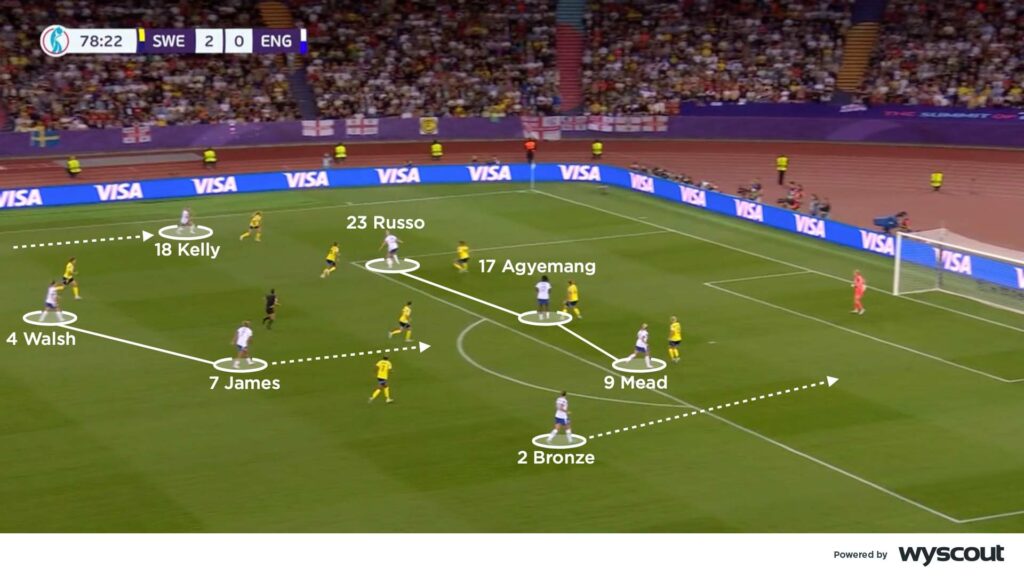
WOMEN’S EURO 2025 QUARTER FINAL, JULY 17 2025
Asllani (2)
Blackstenius (25)
England win 3-2 on penalties
Bronze (79)
Agyemang (81)
Defending champions England came from two goals down and won a dramatic penalty shootout to edge past Sweden into the Euro 2025 semi finals. The Lionesses were on the brink of elimination several times in this meeting in Zürich, but showed tremendous nerve to sustain the defence of their title. In the end they needed every bit of determination, skill and, at times, good fortune to become the first team to progress from a knockout tie at a women’s Euros having trailed by two or more goals.
Sweden had raced into a deserved two-goal lead in the opening 25 minutes, as they brilliantly exposed England’s defensive frailties. Sarina Wiegman’s England improved in the second half, but looked to be running out of time – then two goals in as many minutes brought them rapid parity. To their credit the Swedes regained their composure, taking the game to England in extra-time, but neither side could find a winner.
And so it went to penalties, where the teams struggled to finish each other off, as nine of the 14 penalties were either saved or missed. Fortunately for England, they have now won all three of their penalty shootouts under Wiegman, having lost each of their previous four.
Below, our UEFA-licensed coaches have picked out the kay tactical highlights from a thrilling quarter final…
How the managers saw it
“We wanted to start the game a lot better than we did,” said Wiegman. “Then really quickly they scored a second goal and we were struggling. Then we wanted to think about how could we help the team. We started playing a bit better but we didn’t create much. In the second half we were on the ball a lot more.”
“All analyses now feel pretty meaningless,” said Sweden’s Peter Gerhardsson, after what proved to be his final game in charge. “Right now, it’s more emotions… you get a little melancholic. You feel a sense of sorrow, you’re sorry that it ended like this.”
 122614415161891911126165410823711
12261441516189191112616541082371111/5
SHOTS / ON TARGET
15/3
42%
POSSESSION
58%
26
ATTACKS INTO AREA
40
1.75
EXPECTED GOALS (XG)
1.44
Sweden transitioning from England’s poor build
Sweden’s early pressure majorly disrupted England’s build-up play, including working their opening goal from a high regain after two minutes. Jumping out of midfield, Kosovare Asllani pressed England’s centre-backs, working alongside centre-forward Stina Blackstenius. Right-winger Johanna Rytting Kaneryd then pressed high on to her direct opponent, Alex Greenwood, as England were sloppy on the ball, early on. England made plenty of forward runs, but Sweden’s centre-backs picked them up easily. As a result, Sweden dealt comfortably with England’s numerous long balls (below). Wiegman’s side struggled to connect into central midfield and didn’t find their spare player enough.

England’s sloppiness on the ball also helped Sweden maintain their transitional threat throughout the first half. Converting to a back three in possession, England’s back line was particularly stretched when they lost the ball. Right-back Lucy Bronze was so high, so early, that she was unable to offer any support when recovering back. Sweden’s significant central presence when pressing gave them numbers to attack with, and they looked particularly potent whenever they regained possession high (below).

Sweden’s attacking transitions were also dangerous when they regained the ball inside their own half. Leah Williamson and Jess Carter struggled to handle Blackstenius’ direct running, with Sweden’s early balls targeting the space in behind England’s centre-backs. Whenever England’s midfield lost possession and they struggled to counter-press to force play backwards, Sweden’s forward passing created chances. Their incisive and direct second goal (below) was a perfect example of their threat on transition.

Wiegman’s second-half tweaks
In the second half, England connected better via more short passes, while also reducing Sweden’s number of attacking transitions. England’s central-midfield three played closer together for longer, building around the jumping Asllani. Wiegman also swapped her wingers over, creating a narrower front three for Ella Toone, Georgia Stanway and Keira Walsh to find with shorter passes to feet (below) – as opposed to the first half, when the midfield watched long balls sail over their heads to England’s previously isolated attackers. Alessia Russo in particular benefited from this extra support, finally connecting and linking the play as the single centre-forward.

Sweden soon narrowed in an attempt to limit access into England’s central midfield. The key for England was then wider passes around. Having swapped the wingers, this resulted in more diagonal dribbles back inside the pitch from Lauren James and Lauren Hemp. This pair looked to connect inside with England’s attacking midfielders, Toone and Stanway, whose positioning was now much more dangerous – sometimes totally free to receive, well away from Sweden’s centre-backs. Russo’s movements to England’s left allowed Stanway in particular to make forward runs. With James consistently driving inside, Toone found better pockets of space to connect with Hemp, as England started to create chances (below).

It still took a significant restructure for England to level the game, however. Wiegman added Michelle Agyemang, Chloe Kelly and Beth Mead to the attack, changing England to a 3-4-3 in possession. Kelly attacked from the left, providing fantastic inswinging crosses for the central numbers to attack. Bronze, meanwhile, continued to move high from right-back and provided width. Russo, Agyemang and Mead formed a narrow attacking trio to attack the box, but also linked short and long passes as England threw numbers forward. James, meanwhile, dropped deeper to form a double pivot alongside Walsh, but still had licence to run and dribble forward.

Wiegman’s changes gave England numbers in central spaces to combine and attack, plus an attacking presence inside the penalty area. They yielded goals from Bronze and Agyemang that stunned Sweden, and ultimately helped the European champions stay alive in the competition.
To learn more from professional coaches at The Coaches’ Voice, visit CV Academy


